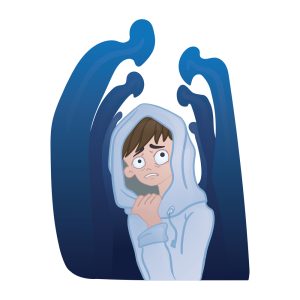Phobias are irrational fears of things, places, or situations that pose no true threat. Millions of individuals suffer from a broad range of phobias from fears of heights, spiders or snakes or dogs, flying in an airplane or driving a car, the dark, bodies of water, the sight of blood or needles or even public places. Phobias fall into the category of anxiety disorders. Phobias and panic attack and the symptoms associated with them are all interrelated types of irrational fears that result in a fear and stress response within the body. Phobias are classified by the DSM-5 as specific, anxiety disorders or agoraphobia, the fear of public places and people. While anxiety is concerned with future impeding stressors, phobias while irrational exist in the moment when put into contact within the stressor, object or situation.

Particular phobia names include: Arachnophobia (spiders) , Ophidiophobia (snakes) , Acrophobia (heights) , Aerophobia (flying) , Amaxophobia (driving), Cynophobia (dogs), Astraphobia (storms) , Mysophobia (germs), Trypanophobia (needles), Hemophobia (blood), Claustrophobia (close places), Nyctophobia (dark) , Pyrophobia (fire) and Dentophobia (dentist).
Many individuals will be triggered by a phobia and panic, cry, flee, overreact, or avoid situations associated with them. Individuals may feel threatened or in danger or disconnected from reality. This can cause physical symptoms of nausea, sweating, trembling, loss of breath, or increased heart rate. When life styles are altered or severe restrictions to life occur, then a phobia is no longer mild and needs counseling and treatment.
Causes of Phobias
Phobias have numerous origins within the person. Some are genetic while others are environmental and learned behaviors. Many phobias generate from classical conditioning at a younger age via a traumatic event. Within classic conditioning there is a conditioned stimulus and a unconditioned stimulus which results in a conditioned response. The conditioned stimulus is associated with the unconditioned stimulus and hence is tied with the unpleasant event. An example would include someone who was in a high place (CS) and experience an event where they fell or almost fell (UCS). The conditioned response resulted in a fear of falling associated with the high place. Hence a fear of high places becomes associated with the fall. This can be applied to any type of phobia.

In addition, an individual at a young age may experience an event of another person and emulate that same experience. Vicarious conditioning occurs when the person witnesses a traumatic event and inherits the same fear. Hence, if a child witnessed his/her mother scream and run from a spider or a snake, this imprinted fear carries on in life with the child. Also, some may read or study a particular thing or event and inherit a fear of it although never associated with it at a personal level.
In regards to general anxiety and agoraphobia, the fear of public places, there is also studies that support genetic predisposition.
The Brain and Phobias
The Limbic system processes emotion. The amygdala processes danger and fear and can invoke a response. In addition, the hypothalamus plays a key role in activating the pituitary gland in activating the fight or flight response. Hence when emotionally charged situations emerge, as well as threats, the body prepares a response. True fears and threat invoke the sympathetic system to produce cortisol and other hormones to raise blood pressure, tighten muscles and prepare the body to defend itself. Phobias create the same tension and anxiety within the person but minus a true threat but only perceived threat. The hippocampus which is essential in forming memories, receives impulses from the amygdala and hence imprints within the memory an event associated with distress. These events are also stored in various areas associated with the cortex of the brain and interestingly enough, certain areas of disgust or fear within facial expressions correspond with those areas in the cortex.
Treatments
Phobias, unless severely anxiety driven, are usually treated with exposure therapy. This involves gradual exposure to the phobia in a safe and calm environment. Hence if one fears spiders, the exposure will begin with simple thoughts, then led to pictures and possibly later interaction with a real spider. Cognitive Behavioral Therapy (CBT) can also be utilized to rationally discuss the phobia and reframe the illogical fear of it. It will review the past trauma and logically try to understand the rational behind the fear. Part of healing is understanding that the fear alerted within the brain is for something that is not a true threat. Retraining the brain to respond in a normal fashion is the key within this therapy. Learning to calm oneself is also key in overcoming phobias. Hence meditation can help reduce the arousal within a given moment.

EFT or the Emotional Freedom Technique is also a way to help reduce the impact of phobias. EFT looks to remove negative energy associated with trauma or thoughts and help the body remove that negative energy through a series of tapping. The tapping looks to retrain the emotional arousal associated with the thought, object or animal. The key is to reduce arousal correlated with the thought so that the thought or trauma becomes less intrusive to the individual when he/she comes upon it.
Hypnotherapy and Phobias
One of the least physically evasive and alternative ways to deal with phobias is through hypnosis. Clinical Hypnotherapy can help find the root of the issue in a relaxing setting and under a slight subconscious relaxed state deal with the phobia and trauma. It can help identify the root cause, the tension felt, and help learn to reframe it and lower arousal when in various situations. Clinical Hypnotherapists can teach patients how to calm oneself when in the presence of a phobia and learn how to positively reframe it. When flying, one can utilize self hypnosis and meditation to help alleviate the arousal state as well. Self hypnosis can be utilized whenever enters into a stressful situation. Special mantras and other ways to alleviate the arousal of the event can also be utilized
Conclusion
Phobias are irrational but real enough within the mind to cause anxiety and fight or flight responses. Through identification of the root cause, cognitive behavioral therapies, gradual exposures and alternative methods, one can alleviate the intensity of them. This is especially true for severe and crippling cases. If one can even reduce severity to a point of functionality, this can be beneficial in reaction to situations. Easier said then done but sometimes necessary for certain extremes and types of phobias.

Please also review AIHCP’s EFT Program as well as AIHCP’s Clinical Hypnotherapy Program. Both programs are online and independent study and open to qualified professionals who are looking to utilize EFT or hypnosis in their practice. While these two models of care do not require licensure, many licensed counselors still like to utilize them. These types of certifications can enhance a professional practice and resume.
Additional Resources
“Phobia” Wikipedia. Access here
“Phobias”. Cleveland Clinic. Access here
“10 of the Most Common Phobias”. Cherry, K. (2022). VeryWellMind. Access here
“Using Hypnotherapy to Treat Phobias”. Jack, C. (20220). Psychology Today. Access here
